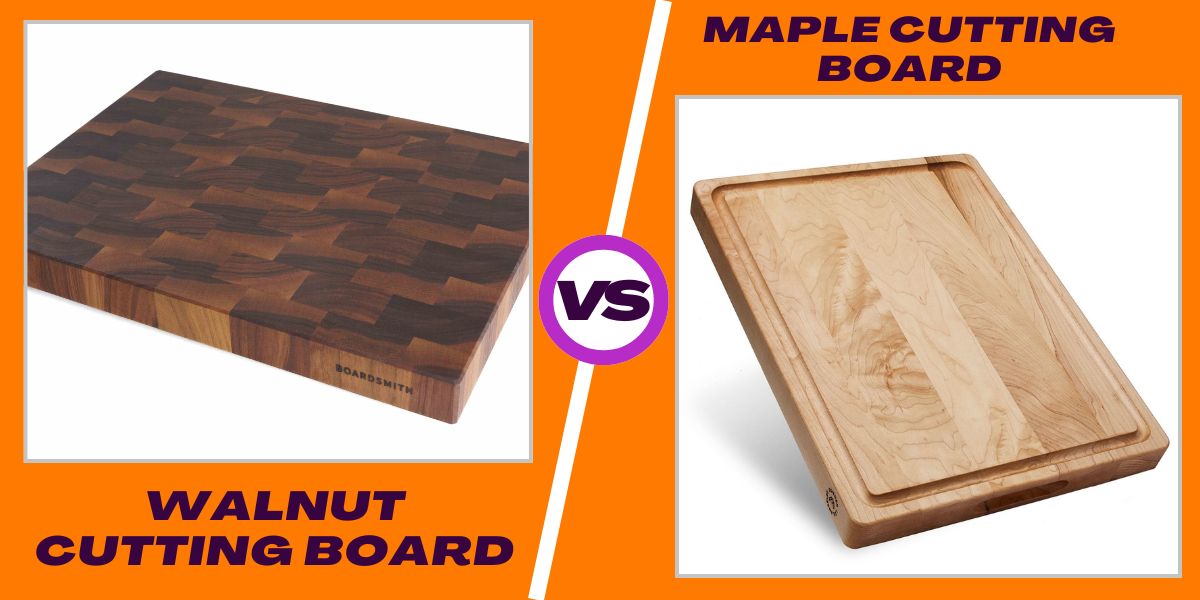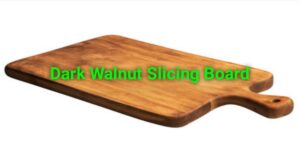Choosing between a walnut vs maple cutting board? I’ve been there, browsing through kitchen aisles, weighing beauty against function. I’ve used both, and let me tell you, each has its charm and flaws. Whether you’re eyeing that sleek walnut cutting board or the clean look of maple, there’s more to the story. From weight to price to wear over time, I’ve got thoughts based on real use. Stick around if you’re stuck between the two. I’ll walk you through what I’ve learned, so you can decide what fits your kitchen best.
Walnut Cutting Board Review
Ever wonder why a walnut cutting board feels so good under a knife? I sure did. I’ve tried many boards over the years, but walnut always stood out. There’s a reason people rave about it, especially when asking, “Is walnut good for cutting boards?” From casual chopping to full-on meal prep, it’s been solid. I’ve used everything from basic models to premium picks like the Boos walnut cutting board. Each has its perks and quirks. If you’re on the fence, stick with me. I’ll share what I’ve learned and what might matter most in your kitchen, too.
What I Like
Over the years, I’ve used different cutting boards, plastic, bamboo, even glass (ouch!). But my walnut cutting board quickly became the one I reach for every day. Here’s why:
- Looks great on any counter – The dark, rich wood grain of walnut just feels upscale. I don’t hide it in a drawer. It’s part of my kitchen decor.
- Gentle on knives – Unlike glass or bamboo, walnut doesn’t dull my blades. I sharpen less and chop more.
- Durable but forgiving – It has a solid feel without being heavy or overly hard. That balance keeps it from warping or cracking easily.
- Easy to maintain – With regular oiling, it holds up beautifully. Even after months of use, it doesn’t look tired.
- Less staining than lighter boards – I’ve chopped beets and tomatoes, and the stains don’t stick around like they do on maple.
What Could Be Better
No product is perfect, and my walnut board is no exception. But honestly, these are small trade-offs, and they wouldn’t stop me from recommending it.
- It’s not the cheapest option – Compared to bamboo or plastic, a good walnut cutting board can cost more. But I see it as an investment, not a splurge.
- It needs a bit of care – You can’t just toss it in the dishwasher. But a quick oiling once a month keeps it like new.
- A bit on the heavier side – Especially larger boards. Still, I’d take the weight for the stability it gives me while chopping.
- Scratches show over time – Yes, you’ll see some knife marks. But for me, it adds character, not flaws.
My Personal Experience
I’ve been using walnut cutting boards for over two years now. From basic home dinners to big holiday meals, this board has seen it all. I’ve tested it with heavy-duty prep, juicy fruits, and even carving meat. It’s stood strong through it all. I’ve tried a few brands along the way, including premium ones like the Boos walnut cutting board, and they all share that same warmth and reliability. For anyone wondering, is walnut good for cutting boards?, My answer is a big yes, based on daily use and long-term satisfaction.
Design
Design matters to me, not just for looks, but for comfort and ease. My walnut board checks both boxes.
The smooth, rounded edges and natural finish make it feel elegant and safe to handle. I especially love that it doesn’t slide around when I’m chopping fast. Some even come with juice grooves, which are handy for messy tasks. Compared to my old maple board, this one just feels more thoughtful in design. It’s something I’m proud to leave out on the counter.
Performance
I chop a lot, onions, herbs, meat, you name it. And this walnut board handles it all like a champ.
It has just the right balance of firmness and give. My knives glide smoothly across the surface, and I don’t feel like I’m hacking into concrete (which is how bamboo felt). Even after repeated use, there’s no splitting or deep gouging. It’s become my go-to, whether I’m prepping a simple salad or dicing veggies for stew.
Build Quality
When I first picked it up, I could tell this wasn’t some flimsy board pretending to be hardwood.
The walnut is thick and dense, but not clunky. It feels sturdy without being hard to move. Some of the better boards I’ve used, like the John Boos walnut cutting board, are made with long-term use in mind. They don’t warp with humidity and don’t flake at the edges. That’s what makes walnut special, it’s strong, but not brittle like some other woods.
Features
Beyond the basics, the little details make this board stand out.
Some versions come with rubber feet for grip, others have built-in grooves to catch juices. Even the plain flat ones are versatile; you can use one side for raw meat and the other for veggies. The natural resistance of walnut to bacteria is also a plus. Compared to a plastic board, I don’t feel like I have to sanitize it with bleach after every use. It’s a quiet powerhouse, reliable, practical, and beautiful all in one.
Would I recommend a walnut cutting board? Without a doubt. If you’re after something that looks great, works well, and lasts for years, it’s a solid pick, literally and figuratively. Whether you’re a home cook or just need a board that won’t let you down, it’s worth checking out. Give it a try, you might be surprised by how much it changes your kitchen game.
Maple cutting board review
Some things just feel right in the kitchen, and for me, that’s my maple cutting board.
It’s simple, strong, and doesn’t scream for attention, but it always gets the job done.
I’ve used plastic, bamboo, even walnut, but maple strikes the perfect balance.
From the classic look to the soft feel under the knife, it’s just easy to love.
If you’re looking for a solid, reliable board (think John Boos maple cutting board quality), this is worth a look.
I’ll walk you through what makes it special and where it could be better, so you can decide if it’s right for you.
What I Like
After using my maple cutting board for a while, I’ve come to appreciate its charm. It’s the kind of kitchen tool that quietly proves its worth, day after day.
- Gentle with knives
Maple is softer than glass or bamboo, so it doesn’t dull my blades. That means I spend less time sharpening and more time cooking. - Easy to clean
I just wipe it down, and it looks fresh again. It doesn’t stain easily, which is a big win when I’m chopping tomatoes or herbs. - Classic look
There’s something cozy about the light, warm grain of a maple cutting board. It feels natural on the counter, like it belongs there. - Durable but not too hard
It takes the hits without getting deep cuts. That balance makes it last longer and keeps the surface looking smooth. - Great for all tasks
Whether I’m slicing bread or prepping veggies, it holds steady and doesn’t slide around. It’s become my go-to board for almost everything.
What Could Be Better
No cutting board is perfect, and while I do love my maple board, there are a few things that could be improved. Nothing deal-breaking, but worth noting.
- Needs regular oiling
If I skip a week, it gets dry and starts to look tired. I’ve learned to treat it with mineral oil to keep it happy. - Not ideal for super wet tasks
When I’m working with juicy meats or fruits, the board can absorb some moisture if I’m not careful. I just use a backup for messier jobs. - Can show wear over time
Little knife marks do show up after a while. It’s part of the charm, but I know some people prefer a pristine surface.
Even with these small quirks, I still reach for it every day. It’s a solid, reliable tool that earns its place on my counter.
My Personal Experience
I’ve been using a maple cutting board for over two years now, and it’s easily one of my favorite kitchen essentials. I’ve tried others, plastic for ease, bamboo for looks, but I keep coming back to maple. It just works. From everyday cooking to holiday prep, it’s held up like a champ. If you’re eyeing something like a John Boos maple cutting board, I get the hype, it’s built for cooks who care.
Design
Maple cutting boards have a clean, soft look. The light grain blends into most kitchen styles, whether your kitchen is rustic or modern. Mine has a simple rectangular shape with smooth edges, which makes it easy to lift and clean. It’s not flashy, but it feels thoughtful and crafted with care. That quiet beauty makes it feel like more than just a tool.
Performance
In the kitchen, performance matters. And my maple board delivers. It’s sturdy without being bulky. It doesn’t slip or wobble, even on a quick chop. I’ve sliced everything from soft bread to firm squash, and it holds up every time. I don’t baby it, and it doesn’t need much. Just a rinse and dry, and it’s ready to go again.
Build Quality
You can feel the difference when something’s well-made. My board is thick, with tight grain and no warping after months of use. It’s solid but not heavy, with clean lines and no rough edges. That’s what makes maple special. It’s dense enough to last, but forgiving enough to protect your knives. You can tell this isn’t a cheap throwaway board; it’s made to stay.
Features
What makes maple stand out isn’t just how it looks, but how it works. It doesn’t fight with my knives. It holds its shape. It’s easy to clean and easy to live with. Some boards demand attention; this one just shows up and does its job. Whether you’re prepping for a family dinner or just slicing an apple, it steps up every time. It’s a quiet overachiever.
Maple Cutting Board vs Walnut Cutting Board: Detailed Comparison
I’ve been testing out both a maple cutting board and a walnut cutting board in my kitchen for months now.
Each has its charm and perks, depending on what you value most: looks, feel, or durability.
Here’s a quick comparison to help you decide which one suits your style better.
| Feature | Maple Cutting Board | Walnut Cutting Board |
|---|---|---|
| Wood Hardness | Medium-hard (gentle on knives, still durable) | Slightly softer than maple, more forgiving |
| Grain Pattern | Light, tight grain with a clean look | Rich, dark grain with a warm, elegant vibe |
| Knife Friendliness | Very good; won’t dull blades quickly | Excellent; extra gentle on edges |
| Stain Resistance | Resists stains well, needs regular oiling | Better at hiding stains due to a darker tone |
| Maintenance | Needs frequent oiling to prevent drying | Same care, but wear is less noticeable |
| Style & Aesthetic | Bright and classic, it blends into modern kitchens | Bold and luxurious, it stands out beautifully |
| Weight & Feel | Lighter feel, easy to move | Slightly heavier and more solid |
| Cost Range | Generally more affordable | Slightly pricier due to wood quality |
Both options are top-notch. If you want a light, classic board that’s reliable and easy to pair with any kitchen, go for maple. But if you’re after a richer tone and a little extra elegance, walnut might just steal your heart.
Let me know if you’d like this styled further for your blog with custom CSS, or want to turn this into a downloadable guide!
My Final Thoughts: Walnut vs Maple Cutting Board
If you love deep, warm colors and a soft touch for your knives, the walnut cutting board is a great choice. If you want a clean look, good price, and extra strength, maple might suit you better. I’ve used both, and they each shine in their way. One feels rich and smooth, the other firm and fresh. Think about how you cook and what your kitchen needs. Either way, you’re picking a solid board that’s kind to your knives and easy on the eyes.
Read More: Acacia vs Bamboo Cutting Boards
FAQs
Is walnut or maple better for a cutting board?
Both are great! Walnut is softer and gentler on knives, while maple is harder and more durable. It depends on your cooking style. Learn more about each.
Does a walnut cutting board last long?
Yes, with care. Walnut boards can last for years. Just oil it often and avoid soaking. It ages well and adds charm over time. Discover care tips inside!
Is maple wood safe for cutting boards?
Absolutely. Maple is non-toxic, closed-grain, and tough. That’s why it’s used in pro kitchens. It’s a smart pick for daily use. Learn more in the guide.
Why choose walnut over maple for a cutting board?
Walnut feels smoother and looks richer. If you like style with function, walnut is your match. Want a sleek board? You’ll love the details inside.
What makes maple cutting boards so popular?
They’re strong, affordable, and easy to clean. Maple boards are loved for good reason, they handle wear like a champ. See how they hold up in real use!



